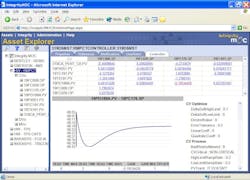Asset management solutions provide the critical functions of monitoring, tracking, allocating and maintaining manufacturing resources. Typically, they are used to squeeze every last dollar out of expensive plant automation equipment by ensuring optimal asset utilization and cost-effective lifecycle management.
Most major automation suppliers sell asset management solutions that work well across their own solutions to document system configurations and changes. The reality, however, is that the typical process plant automation system is a layered architecture of multi-brand, “best-of-breed” systems for field instrumentation, regulatory and safety related controls, advanced process controls, historians and production management systems. Single-supplier solutions cannot provide a cross-system look at the various types and brands of equipment in a single plant and throughout a manufacturing enterprise.
Enter a new product from PAS Inc.—called Integrity.Moc—that is designed to provide asset management across equipment from multiple vendors. Eddie Habibi, president and chief executive officer of Houston-based PAS, compares the Integrity.Moc to a Google search engine. “We’ve developed a Google for private, proprietary, intellectual automation assets. The Integrity.Moc searches ‘islands of automation’ and provides a common view, or user interface, just like Google does. It’s more sophisticated than Google, however, because it creates relationships between assets,” he explains. “For example, it can track a signal from a DCS (distributed control system) through the control strategies, historian, advanced controls and all the way up to the ERP (enterprise resource planning) system.”
Prior to launching Integrity.Moc, PAS developed the DOC3000, a document management system for Honeywell Process Solutions’ distributed control systems. A director of engineering at a major chemicals manufacturer told PAS that he loved the DOC3000 system, but needed a solution that would work across equipment from multiple vendors and in multiple plant sites.
Says Habibi, “It requires intimate system knowledge to do the data mining in automation equipment. Previously, we embedded this knowledge in the PAS DOC3000 software.” To provide vendor neutrality, PAS separated the application from the database by developing asset models for different vendors’ equipment. “The knowledge base takes the unique raw data from the automation system and converts it to a common data model,” explains Habibi.
This approach provides automatic documentation, data visualization, data mining, change management and data integrity management across various equipment. According to Habibi, the resulting benefits include increased productivity, reliability and safety. Currently, Integrity.Moc supports Honeywell and Invensys Foxboro systems, with other systems under development.
About the Author
Jane Gerold
Automation World

Leaders relevant to this article:
